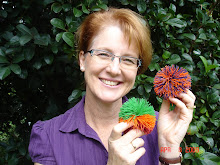4. Raise my hand to ask a question.
5. Six feet flat on the floor!
6. Loving Choices.
Now for a quick explanation of each.. ....
I have found it necessary to reward this first behaviour particularly when you are in a new classroom situation. Raising your hand is the best way to manage the class discussions in an orderly way. When you know the class and a relationship has been established, ground rules can change to suit your teaching style. I often explain to an upper primary group that even in staff meetings, adults will raise their hands in order to indicate that they would like to make a verbal contribution to the discussion. It is the chair person's role to make sure that every one's ideas are heard and valued.
This symbol always brings a chuckle. Older children get the six feet concept straight away. (That is six in a circle under the chair drawing by the way.) Younger children may require a visual count of the four feet of the chair and two feet of the student making six feet flat on the floor. This rule may be selfish on my behalf as I can't count the number of times I have had a chair come down on my toe or clipped a chair leg as I moved past. (Work Place Health and Safety is my excuse!) I tend to circulate constantly around the students in whatever learning environment I am presented with. I believe this teaching style is called "a river" however, if you prefer a "mountain" style perhaps this rule will not be as necessary. Proximity to the student who requires attention is another practical behaviour management technique without being too obvious.
Last but not least is the much broader symbol of loving choices. I teach in schools with a Christian ethos and therefore, this language, and the behaviour it implies, is readily understood by the students. You could easily change loving to good choices. I think all children understand these choices come form the heart!
My six rules are my base set. I do not always use all of them. I change depending on the needs of the class. There are some days that I have not introduced the rules at the beginning of the school day and find I need to define ground rules after the first break. This works well too. The visual symbols on the board are a reminder of the expectations.
Sometimes, I like to ask the class what their special class/ school rules are so we can all enjoy a happy day. This is an interesting insight into the social functioning of the class as a group. Nearly always I can record my symbols as the class recounts their class rules. The class can then see these symbols as their own.
The other thing I like to do is highlight a rule that I will be especially rewarding during a certain time frame. For example: During group research work, I will be listening for kind words and watching for people trying their best. Other times I will secretly ask a couple of children to watch for two other children they saw making loving choices during a session. Children placing value on their peer's behaviour is a very powerful teaching tool.
There are even some occasions when a child with particularly high needs has really benefited from observing his class mates with a specific intention...... to learn more about acceptable behaviour! I don't make this a punishment, rather a task. Based on the random rule symbols and whatever behaviours I would like the child to focus on, I draw up a simple tally chart with the symbol on one side and a division to place tally marks for each time they observe this specific behaviour in the working classroom. You may want to get more specific......an eye diagram for keeping an eye on the speaker, or glue bottle when sharing the glue or hearing the words"Excuse me!" Whatever you choose don't make it too involved, have a time limit and keep it as a task not a punishment. The child will learn more than you will ever know!
I would ask the child what did they enjoy learning from this task. Their response may surprise you. I record this as a summary statement for this learning experience. I usually keep this to share with the class notes at the conclusion of the day. Often the student will be quite proud of their observations and would like to keep it themselves.
Behaviour management is both complex and interesting, especially to the substitute teacher. There is never a day when I don't learn something new about child behaviour. Remember you are dealing with children who are in different developmental stages...not mini adults!
Love to hear your feedback. Thanks for taking the time to read this blog.
Blessings for the journey.....
Live,laugh and learn!
Carmel


No comments:
Post a Comment